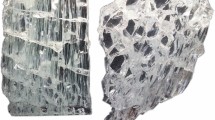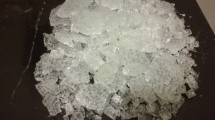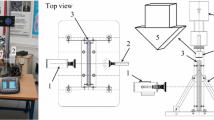Abstract
This work presents the relation between the fragment density and the permanent residual stress in fragmented tempered glasses of various thicknesses. Therefore, fracture tests were carried out on tempered glass plates and the fragments in observation fields of 50 mm \(\times \) 50 mm were counted. The average fragment density in the observation fields was set in correlation with the average measured residual stress of each specimen. Furthermore, the average particle weight of 130 particles per specimen chosen by random was determined. The relation between the average particle weight and the measured residual stress is given. The volume and the base surface as well as the radius of the particles are calculated assuming cylindrical fragments with approximately unchanged thicknesses. The relation between the residual stress and the particle base surface of regular polygonal shapes \(n=3\)–8 edges in addition to the cylindrical fragment \((n\rightarrow \infty )\) is also determined. The glass used for the fracture tests was commercial soda-lime-silica glass with three different thicknesses 4, 8 and 12 mm. The results in this work are a basis for the establishment of a theoretical model to predict macro-scale fracture patterns from elastic strain energy in tempered glass.























Similar content being viewed by others
References
Acloque, P.: Deferred processes in the fragmentation of tempered glass. In: Proceedings of the 4th International Glass Congress, vol. 6, pp. 79–291 (1956)
Akeyoshi, K., Kanai, E.: Mechanical properties of tempered glass. In: Proceedings of the 7th International Glass Congress, vol. 14, pp. 80–85 (1965)
Aronen, A.: Modelling of deformations and stresses in glass tempering. Ph.D. thesis, Julkaisu-Tampere University of Technology, Publication 1036 (2012)
Aronen, A., Karvinen, R.: Effect of glass temperature before cooling and cooling rate on residual stresses in tempering. Glass Struct. Eng. (2017). https://doi.org/10.1007/s40940-017-0053-6
Barsom, J.M.: Fracture of tempered glass. J. Am. Ceram. Soc. 51(2), 75–78 (1968). https://doi.org/10.1111/j.1151-2916.1968.tb11840.x
CulletScanner: Version 17.4 (r40671) SoftSolution GmbH (2017)
EN 12150-1: Glass in building – Thermally toughened soda lime silicate safety glass – Part 1: definition and description; German version EN 12150-1 (2015)
Fineberg, J.: The dynamics of rapidly moving tensile cracks in brittle amorphous material. In: Shukla, A. (ed.) Dynamic Fracture Mechanics. World Scientific, Singapore, pp. 104–146 (2006)
Gulati, S.T.: Frangibility of tempered soda-lime glass sheet. Glass Performance Days, pp. 13–15 (1997)
Lee, H., Cho, S., Yoon, K., Lee, J.: Glass thickness and fragmentation behavior in stressed glasses. New J. Glass Ceram. 2, 138–143 (2012)
Martin, H.: Heat and mass transfer between impinging gas jets and solid surfaces. Adv. Heat Transf. 13, 1–60 (1977). https://doi.org/10.1016/S0065-2717(08)70221-1
Mognato, E., Brocca, S., Barbieri, A.: Thermally processed glass: correlation between surface compression, mechanical and fragmentation test. Glass Performance Days, pp. 8–11 (2017)
Narayanaswamy, O.S.: A model of structural relaxation in glass. J. Am. Ceram. Soc. 54(10), 491–498 (1971). https://doi.org/10.1111/j.1151-2916.1971.tb12186.x
Nielsen, J.H., Olesen, J.F., Stang, H.: The fracture process of tempered soda-lime-silica glass. Exp. Mech. 49(6), 855–870 (2009a). https://doi.org/10.1007/s11340-008-9200-y
Nielsen, J.H.: Tempered glass: bolted connections and related problems. Ph.D. thesis, Technical University of Denmark, Department of Civil Engineeing (2009b)
Nielsen, J.H.: Remaining stress-state and strain-energy in tempered glass fragments. Glass Struct. Eng. 2, 45–56 (2017). https://doi.org/10.1007/s40940-016-0036-z
Nielsen, J.H., Olesen, J.F., Poulsen, P.N., Stang, H.: Finite element implementation of a glass tempering model in three dimensions. Comput. Struct. 88(17–18), 963–972 (2010). https://doi.org/10.1016/j.compstruc.2010.05.004
Pourmoghaddam, N., Nielsen, J.H., Schneider, J.: Numerical simulation of residual stresses at holes near edges and corners in tempered glass? A parametric study. In: Engineered Transparency International Conference at Glasstec, pp. 513–525 (2016)
Pourmoghaddam, N., Schneider, J.: Finite-element analysis of the residual stresses in tempered glass plates with holes or cut-outs. Glass Struct. Eng. [Online]. https://doi.org/10.1007/s40940-018-0055-z (2018)
Schneider, J.: Festigkeit und Bemessung punktgelagerter Gläser und stoßbeanspruchter Gläser. Ph.D. thesis, Technische Universität Darmstadt (2001)
Shutov, A.I., Popov, P.B., Bubeev, A.B.: Prediction of the character of tempered glass fracture. Glass Ceram. 55(1–2), 8–10 (1998). https://doi.org/10.1007/BF03180135
Tandon, R., Glass, S.J.: Fracture Mechanics of Ceramics; Active Materials, Nanoscale Materials, Composites, Glass, and Fundamentals, vol. 14, pp. 77–92. Springer, Berlin (2005)
Warren, P.D.: Fragmentation of Thermally Strengthened Glass. Fractography of Glasses and Ceramics IV, pp. 389–402. The American Ceramic Society, Westerville (2001)
Author information
Authors and Affiliations
Corresponding author
Ethics declarations
Conflict of interest
The authors declare that they have no conflict of interest.
Additional information
Publisher's Note
Springer Nature remains neutral with regard to jurisdictional claims in published maps and institutional affiliations.
Rights and permissions
About this article
Cite this article
Pourmoghaddam, N., Schneider, J. Experimental investigation into the fragment size of tempered glass. Glass Struct Eng 3, 167–181 (2018). https://doi.org/10.1007/s40940-018-0062-0
Received:
Accepted:
Published:
Issue Date:
DOI: https://doi.org/10.1007/s40940-018-0062-0




